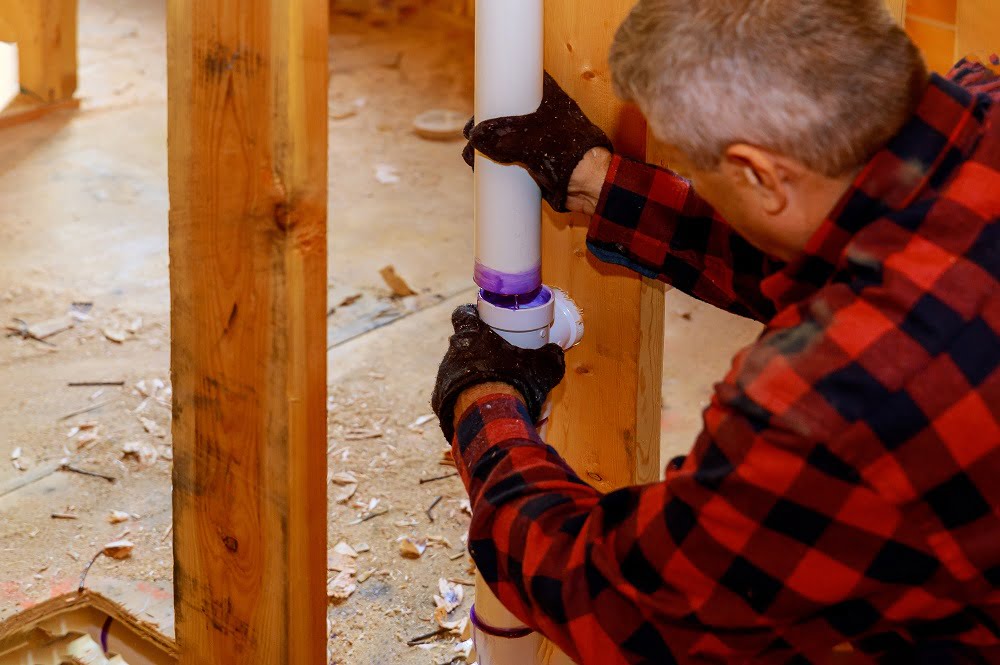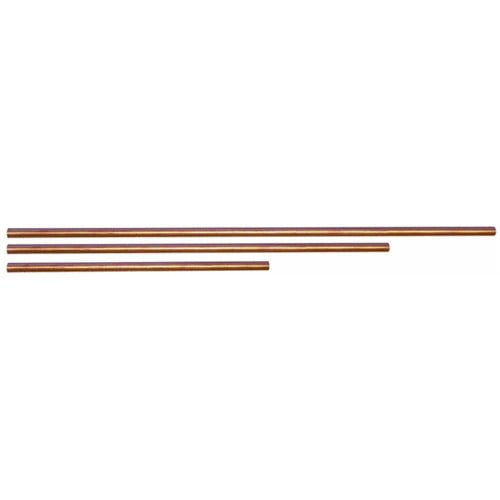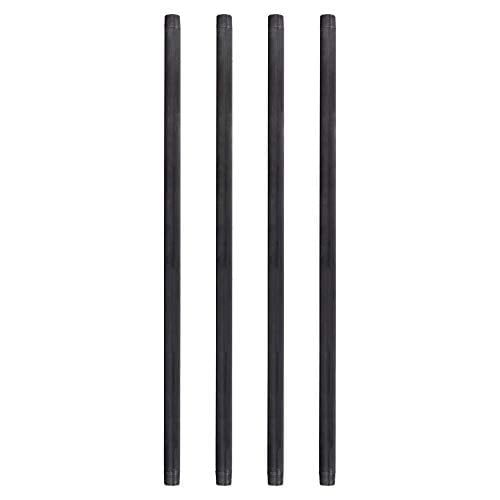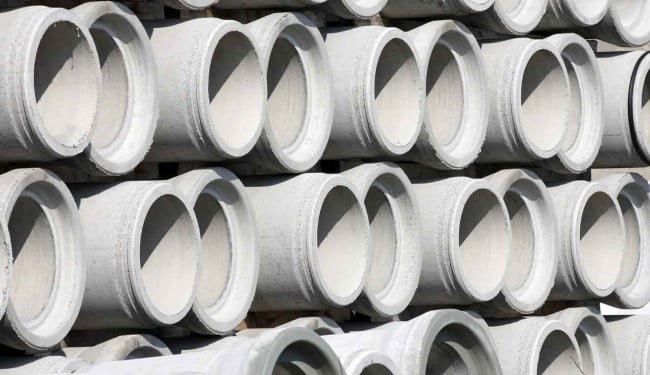Can we all agree that building the right plumbing system is no walk in the park?

Whether you plan to hire a professional or get on a DIY project, knowing about the different plumbing pipes is virtually indispensable. Trust us; it won’t take you long to ask, “which pipe should I go for?”
And the plethora of options on the market won’t do you much good unless you have a fair idea about their use and maintenance. So, here we are to guide you about the types of plumbing pipes and their most common uses.
Now, let’s dive into the deets, shall we?
Types Of Plumbing Pipes
-
PVC
PVC or polyvinyl chloride pipes are perhaps the most common and inexpensive type used in plumbing jobs. Essentially made of a thermoplastic chemical, these cream or white-colored pipes are popular due to their lightweight nature, making it easier to work with them. All you need is a miter box, hacksaw, and some solvents for gluing the pipes together.
On top of that, their durability, strength, and versatility are second to none. And talking about the latter, you can use PVC pipes for various purposes like vents, drains, and waste lines, as well as for potable water lines and sewage applications. Plus, they can also be used for stacks, i.e., the pipes that stick out of the roofline.

Depending on the intended use, these come in different diameters, which are mostly mentioned on the surface of the pipe itself. For instance, Schedule 40 PVCs are extremely strong and often used for residential drain lines. Likewise, the heat-resistant properties of CPVC (chlorinated PVC) pipes make them suitable for interior supply lines.
On the other hand, the Schedule 80 variant can be used as cold-line supplies since it isn't recommended for hot water lines.
Moving aside from the advantages, we thought there are some downsides that you should be aware of. Firstly, PVC pipes may lose their quality upon getting exposed to the sunlight for prolonged periods. Also, the glued joints tend to leak, and the only way to fix them is by cutting the part and gluing it back.
-
PEX
Also known as cross-linked polyethylene, the color-coded (blue and red) PEX pipes are a relatively new name in the plumbing market. The high-pressure resistance on offer makes them particularly ideal for water supply lines in residences and small business establishments.

But despite having a dedicated purpose, these pipes have quickly become popular among DIY-enthusiasts and professional plumbers alike, thanks to their flexibility and ease of installation.
Furthermore, PEX pipes can be weaved throughout walls, crawlspaces, ceilings, and basements. You can also bend them to 90-degrees for going around the corners of walls. Not only do they cut easily, but you can easily attach these push-fit plumbing fittings. Moreover, they can be joined with copper pipes to create a seamless extension.
Although they cost slightly more than copper or plastic pipes, their longevity is a bit of a concern. And while at it, do keep an eye out for leaks, especially with push-fit plumbing fixtures.
-
ABS

ABS or acrylonitrile butadiene styrene pipes were one of the first pipes to be used for residential plumbing jobs. These look like a black-color variant of the PVC pipes and are softer to touch, but are actually stronger than the PVC ones.
Additionally, ABS pipes are capable of tolerating cold temperatures. Therefore, they are good for exterior and underground use as vent and drain lines. But sadly, not many building codes permit these pipes today. Besides, they may get deformed at certain temperatures, which is a hindrance to their versatility.
-
Flexible Copper
Moving on from the plastic pipes, it’s time for us to introduce the metal variants. And we start off with flexible copper pipes. Featuring an almost helical pattern, these tubings are ideal for shorter runs of water to heaters, refrigerators, and sinks. But they don’t come with a budget-friendly price tag.

Moreover, their pliability is the main reason why these pipes are used for water supply in compact and unusually shaped areas. Using a hacksaw, you can easily cut these pipes to achieve the desired measurement.
That said, their flexibility makes them fragile for use, especially outdoors. And much like ABS pipes, they don’t hold up well in extreme temperatures. But should it kink, you can cut that part and replace it. On that note, we should also mention that flexible copper pipes can be joined with soldering or compression fittings.
-
Rigid Copper
Unlike flexible copper, rigid copper pipes have a small diameter and have been traditionally preferred for water supply lines due to their durability and long-lasting construction. Since copper doesn’t develop rust, it’s the perfect option for a drinking water supply as the water won’t be infused with any harmful chemicals.
Apart from that, you can use these pipes as hot water or steam supply as copper usually doesn’t bend or sag under high temperature. However, their expensive price tag means you may want to limit their use in the household.

Beyond that, rigid copper pipes are available in three thickness variants, detonated by types ‘M’, ‘L’, and ‘K’. Among them, type M is the thinnest but is still strong enough to be used in most homes. Similarly, types L and K are thicker and more suitable for various outdoor and drain applications.
One of the hassles associated with rigid copper pipes is that they aren’t very easy to work with. While you’ll most likely need a tube cutter or wheel cutter for trimming the pipes, joining them requires soldering.
So, if you haven’t done soldering before, we suggest getting professional help. Alternatively, you can practice soldering at home, provided you have the required tools and a few extra pipes to spare. Also, rigid copper pipes may develop pinholes overtime, or corrode from the inside to ultimately hamper water flow. Hence, frequent replacements may be necessary, especially with continuous heavy duty use.
-
Cast Iron
Cast iron pipes can be predominantly found in homes built before 1960 for vertical drain, vent stacks, sewer applications, and horizontal drain purposes. Featuring a robust pig iron construction, most cast iron pipes have a diameter anywhere between 5 and 120-centimeter.
Although they aren’t rustproof per se, you can use them until the point where they are completely rusted through.
In fact, cast iron pipes can be expected to last up to a century under ideal circumstances. Therefore, it comes as no surprise that they are extensively used for city water distribution systems.

The usual length for residential use is about 12 feet, but you can extend it up to 20 feet if needed. And depending on the use, the pipes can have a thickness value of up to 350 psi for tolerating increased pressure. While larger pipes come with a lining of cement mortar, the smaller ones have bituminous compound coating for rust-resistance and enhanced hydraulic quality.
Another thing to know is that cast iron pipes meant for plumbing are generally manufactured with a lead bell and spigot joint. A few jute strands are tightly wrapped around the spigot before it’s inserted into the belt. Then, the whole joint is packed with more strands.
As a final step, the space between the bell and spigot is tilled with a molten metal, which caulks tightly into the joint after cooling.
Other than that, several inexpensive materials like patented sulfur compounds and neat cement mortar are also used for producing joints. However, they tend to be less flexible.
Furthermore, the flanged pipe variant is used in pumping stations, filter plants, and similar areas where you may have to disjoint the pipe. A pro tip: replace the chisel and hammer with a cutter and hacksaw for cleaner cuts.
-
Steel
As you may have already guessed, steel pipes are made from stainless steel sheets for everyday use like carrying gas and liquid indoors. Smaller steel pipes have an almost invisible welded joint running along the length, and the larger ones are equipped with riveted joints. The average longevity of these pipes is between 25 and 50 years.
-
Galvanized Iron (G.I.)
No list of plumbing pipes is complete without mentioning galvanized iron pipes. Abbreviated as ‘G.I.’ pipes, they are made from mild steel sheets and are threaded at both ends. You will commonly find them carrying water, gas, or other fluids inside buildings.
Manufacturers generally choose the thickness of the sheet in accordance with the purpose, and the diameters vary from a range of 12-millimeter to 15-centimeter. The standard length hovers around 6-meter. Once the pipes are carved, they are dipped in a zinc solution to prevent rust formation. This process is called galvanizing.
Much like PVC pipes, G.I. pipes are one of the most lightweight options on the market, which makes them easier to work with. You don’t have to put in a lot of effort to cut, thread, or bend them as desired. Additionally, joining them requires nothing more than a simple connecting socket.
Considering that these pipes come with a reasonable price tag, we are pretty satisfied with the 10-year service life (under ideal circumstances). That said, extremely alkaline or acidic water can cause the pipes to corrode faster.
-
Wrought Iron

Wrought iron pipes are almost identical to their galvanized iron counterparts in terms of looks and use, except that they are manufactured by welding wrought iron sheets. Their seamless structure aids flexibility and ease of use. Not only that, but you can use either socket, flanged, or welded joints to connect multiple pieces.
-
Asbestos Cement
Without sounding too technical, asbestos cement pipes are produced from a combination of asbestos, cement, and silica that is converted to a dense homogenous material under high pressure. The resultant mixture is thoroughly combined with more cement for strength building and reinforcement purposes.
Coming to further specifications, these pipes are available in a diameter range of 4 to 36 inches, and the maximum length is about 13 feet. Moreover, the thickness grade varies, with the highest one meant to withstand internal pressures up to 200 psi.

Asbestos cement pipes are mostly assembled with a special coupling (joint) that consists of a pipe sleeve and a pair of twin rubber rings. The latter stays compressed between the pipe and the interior of the sleeve. Besides, the joint is as resistant to corrosion as the pipe itself, so quality isn't an issue.
Contrary to expectations, these relatively lightweight pipes have a pretty straightforward assembly, which doesn't require a lot of expertise. They can be connected to a cast-iron pipe with sulfur or lead-based compounds. Plus, you can cut them and thread as needed.
Another of the likable features is their high hydraulic pressure efficiency, meaning you can use them as regular liquid flow lines. In this regard, the flexible joint facilitates a 12-degree deflection for laying the pipe around curves.
Perhaps the biggest downside is that the rubber-joint seals are less resistant to gasoline and petroleum products, which somewhat impacts the versatility. Also, excavating tools can easily damage the surface of the pipes, so be careful during installation.
-
Concrete Pipe
As we near the end of the list, precast concrete pipes make a deserving entry. A distinct feature of this variety is that the pipes seldom come in smaller sizes. As such, the diameter can extend up to 72-inch, with the length being around 180-inch. Needless to say, precast concrete pipes are primarily used for larger establishments.
Apart from that, pipes with a diameter of more than 24-inches are reinforced using two cylindrical mortar cages. And for this, the structure is rapidly spun around the axis of the pipe.
As a result, the centrifugal force presses the mortar tightly against the surface, thereby forming high-density watertight concrete. Appearance-wise, these reinforcements may take the form of elliptically wound wires or elliptical booms. Reinforced concrete cement (RCC) pipes are specifically designed to tolerate high-pressure flow.
Similar to cast iron pipes, low head concrete pipes mostly use a mortar caulked bell and spigot joint, while those designed for higher pressure utilize a lock joint. At the same time, concrete pipes with heads above 100-feet have a welded steel cylinder on the inside for ensuring water-tightness.
Long story short, the precise manufacturing techniques enhance the quality of precast concrete pipes, making them significantly lean compared to cast-in-place pipes of the same size.
With proper maintenance, concrete pipes should last for about 35 to 50 years, but alkaline water and sulfide corrosion can have detrimental effects. Furthermore, the weight of concrete makes both transportation and maintenance a challenging job.
On a side note: cast-in-place concrete pipes are expensive and customarily used where precast pipes are insufficient to take on the transportation pressure. These are built with diameters between 24 to 72-inch but without any reinforcement.
-
Vitrified Clay Pipe
In contrast to concrete pipes, vitrified clay pipes are not meant to tackle pressure and are widely used in sewage or drainage for flow at low depths. Their smooth and practically corrosion-free surface correlates to extended shelf life and reinforced hydraulic pressure, respectively.
In case you’re wondering, the low strength tension and inability to form watertight joints make the vitrified clay pipes unsuitable for high-pressure flows. The most common joint is the bell and spigot variant that utilizes a precision matted surface in tight contact. Other than that, rubber-sleeve couplings secured with anti-corrosion steel bands may also be used.
Whatever be the type, the joints are often unlatched to allow the flow of water into or out of the pipe.
The length of these pipes start from as low as 2 feet and can go up to 4 feet. Likewise, the inside diameters can be increased by 2-inch in the 4 to 12-inch range and by 3-inch beyond the 12-inch mark. However, you will rarely find vitrified clay pipes with a large diameter.
Final Words
That’s it from us on the types of plumbing pipes.
Hope our efforts help you pick the right pipe according to your needs and, of course, budget. But if you’re looking for other varieties like MDPE pipes, then feel free to click here. After all, very few things match the nightmare that is a faulty plumbing system!
With that, it’s time for us to say goodbye. But before we leave, here are a couple of pro tips: first-timers should always seek professional help for installation or maintenance needs. Secondly, plastic pipes like PVC or ABS should be avoided for hot water supply lines.
See you next time!
